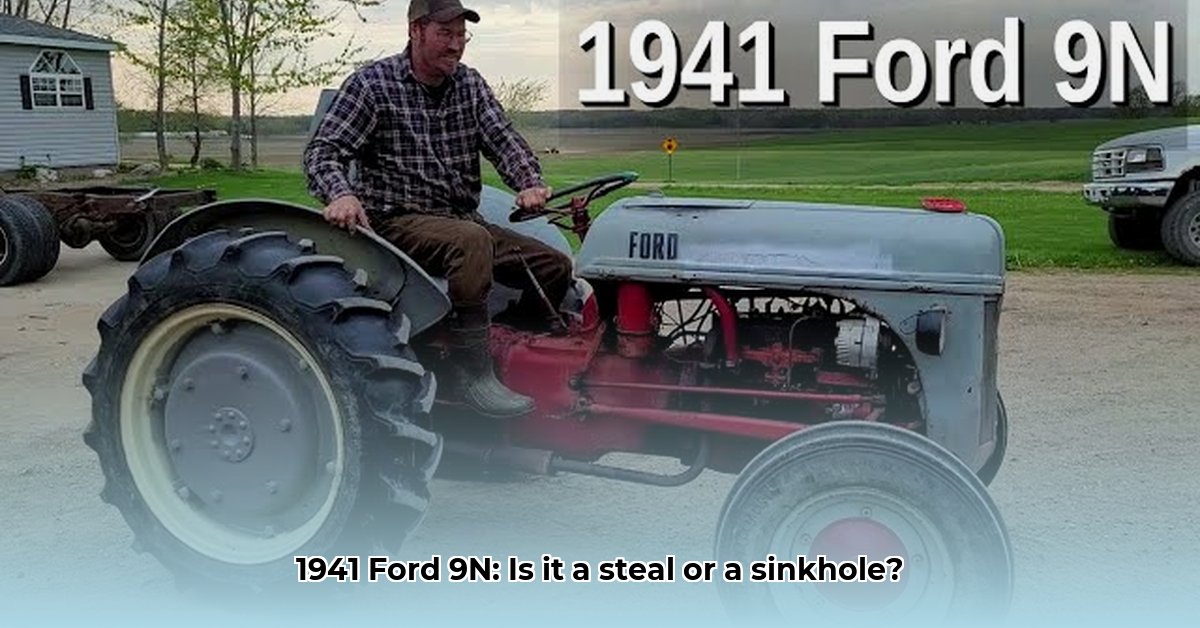
The 1941 Ford 9N tractor, a workhorse of its era, continues to captivate collectors and farmers alike. Over 99,000 of these iconic machines were produced, leaving a lasting legacy on American agriculture. But what determines the value of a specific 1941 9N? Why does one command a premium price while another sells for a fraction of the cost? This guide delves into the factors influencing the value of these classic tractors, offering actionable intelligence for buyers, sellers, and investors. For more information on other classic Ford tractors, check out this helpful resource.
Condition: The Cornerstone of Value
A 1941 Ford 9N's condition is paramount. A meticulously restored tractor, gleaming with original paint and perfectly functioning mechanics, represents a significant investment—and the price reflects this. Conversely, a neglected machine, even with all its parts present, will command a substantially lower price. The difference can amount to thousands of dollars. It's comparable to the classic car market: a concours-ready restoration far surpasses a rusty barn find in value. This is a crucial point to remember when assessing any 9N.
Authenticity: The Allure of Original Parts
A completely original 1941 9N, with matching numbers and all original components, is significantly more valuable than one with missing parts or aftermarket replacements. Collectors prize authenticity. Think of it like finding a rare baseball card – the better the condition, the more complete and original the card, the more valuable it becomes. This principle applies directly to these classic tractors.
Location: A Regional Market Perspective
The geographic location of a 1941 Ford 9N influences its final price. Regions with robust collector markets, rich agricultural heritage, or active vintage tractor communities often exhibit higher prices. This is simple supply and demand—more buyers drive up prices. A pristine 9N might fetch a higher price in a rural area with a thriving antique tractor scene than in a major metropolitan area. Understanding this regional variance is crucial for effective buying and selling.
Assessing the Value of Your 1941 9N: A Step-by-Step Guide
Determining the accurate value of your 1941 Ford 9N requires meticulous attention to detail. Follow this structured approach:
Comprehensive Inspection: Conduct a thorough examination of the tractor, assessing its mechanical components, rust, missing parts, and any modifications. Photographs are insufficient; a hands-on inspection is essential.
Market Research: Analyze online marketplaces and auction results for similar tractors—same year, condition, and included accessories. Focus on completed sales, not just asking prices.
Expert Consultation: Seek advice from experienced mechanics, appraisers specializing in vintage tractors, or knowledgeable enthusiasts within vintage tractor communities. Their insights can be invaluable.
Detailed Documentation: Maintain comprehensive records of your inspection, research, and any necessary repairs. This documentation will prove invaluable during the buying or selling process.
Price Ranges: A Market Overview
Current market trends indicate that a 1941 Ford 9N can range from a few thousand dollars for a restoration project to well over $10,000 for a fully restored showpiece. Remember, these are general guidelines; several factors influence the final price. The market is dynamic, and prices fluctuate.
Actionable Intelligence for Different Stakeholders
The approach to valuing a 1941 9N varies depending on the buyer's goals:
Collectors: Prioritize impeccable condition, original parts, and a verifiable history. Expect to pay a premium for highly sought-after specimens.
Agricultural Users: Focus on functionality and ease of repair. Part availability is crucial. Cosmetic condition is secondary to operational readiness.
Investors: Conduct thorough market research, assessing the potential for appreciation (a long-term perspective is crucial). Risk management should be a priority.
"The 1941 Ford 9N market is complex, requiring a nuanced approach," explains Dr. Amelia Hernandez, Agricultural Historian at the National Agricultural Museum. "Collectors value originality, while farmers prioritize functionality."
Mitigating Risks in the Vintage Tractor Market
Investing in a 1941 9N involves inherent risks. Here's how to mitigate them:
Pre-Purchase Inspection: Obtain a professional inspection from a qualified mechanic before purchasing any tractor.
Thorough Market Research: Conduct comprehensive research to avoid overpaying. Professional appraisal can also be beneficial.
Realistic Restoration Budget: Carefully estimate restoration costs, prioritizing essential repairs.
Reliable Parts Sourcing: Identify reliable parts suppliers to ensure ready access to necessary components.
The 1941 Ford 9N is more than a machine; it's a piece of living history. By understanding the factors influencing its value and taking a thoughtful approach, buyers, sellers, and investors can navigate the market effectively and appreciate the tractor's historical significance and investment potential. Remember, continuous market research and expert consultation are key to successful navigation.